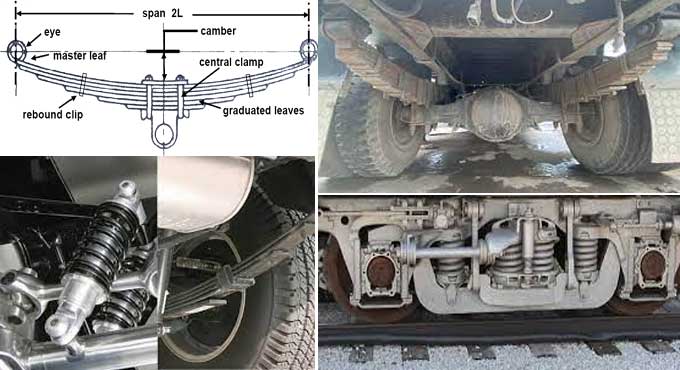
A Comparison of Helical and Leaf Springs in 2023

Spring has a wide range of applications, from low-duty requirements to heavy-duty requirements. An externally applied load can considerably deform a spring, which is a flexible mechanical element.
The spring absorbs mechanical energy and stores it, then releases it in a controlled manner when it regains its original shape and size after experiencing elastic deflection.
When it comes to suspension systems in vehicles, helical and leaf springs are two of the most popular choices.
Define Helical Spring
Essentially, it is a mechanical device that absorbs shock and maintains force between surfaces by storing and releasing energy. Alternatively, helical springs are also called coil springs.
Define Leaf Spring
A leaf spring can also be called an elliptical spring, a semi-elliptical spring, or a semi-elliptical spring. Using a clamp, a series of curved metal plates are superimposed on top of each other to form a spring.
Difference between Helical & Leaf Spring
Construction Process
Multiple flat plates of varying lengths are assembled into a leaf spring using rebound clips and bolts. Although the wire remains helix-shaped, helical springs are hollow and cylindrical. A leaf gradually decreases in length as it grows from top to bottom.
There are two bends at the ends of the topmost leaf, the master leaf. A semi elliptic shape is common to each leaf, as well as the overall shape of the spring. In contrast, helical springs are made by winding wire or coils in a helix form.
Strength & Durability
Helical springs are made of a single steel rod, wound in a helical shape. They are designed to absorb shock and force, and provide a smooth ride for the vehicle. They are known for their strength and durability, and are usually used in heavier vehicles such as trucks and SUVs. They are more expensive than leaf springs, but their longevity makes them a good investment.
Transverse Flexibility
Driving the vehicle on rough roads requires a small amount of suspension deflection in the cross or transverse directions. Taking sharp turns also benefits from such deflection. In cross movement, coil springs can provide such flexibility.
In this way, this type of spring is suitable for cars that are intended to run on rough, hilly, and village roads. Such cross deflection of the suspension system is not provided by leaf springs.
Design
The helical leaf is a single piece design, with a continuous curve that wraps around the edge of the structure. This design is often used on structures that require a uniform load distribution, such as in bridges and load bearing beams.
On the other hand, spring leaf is made up of several individual leaves that are stacked on top of each other. This design is often used on structures that require a variable load distribution, such as in vehicles.
Comfortability
If the vehicle is unloaded on such a road, leaf springs tend to lift the vehicle's body.
Helical springs provide a comfortable, jerk free ride, even on rough roads. Therefore, they are commonly used in passenger vehicles. Consequently, it is preferred in heavy trucks when comfortability is not a primary concern.
Application
Leaf springs, on the other hand, are made of several layers of steel plates attached together. They are designed to absorb shock, but not as much as helical springs. Leaf springs are more commonly used in lighter vehicles, such as passenger cars and minivans. They are typically less expensive than helical springs and require less maintenance, but they do not provide the same level of performance and comfort.
Installation Process
It is also easy to install and provides excellent vibration absorption. It is more difficult to install than helical leaf, but provides a more reliable support due to its variable load distribution.
Load Bearing Capacity
The leaf spring is capable of enduring such jerks without much difficulty. The coil spring may buckle if it is loaded beyond a certain limit.
As heavy industrial trucks are equipped with leaf springs, leaf springs dominate coil springs when it comes to load bearing capacity. Even when vehicles run over speed barkers, even at slow speeds, they exert tremendous reactive force.
Cost
When it comes to cost, helical leaf is often more expensive than spring leaf due to its single piece design, helical leaf provides a much longer lifespan than spring leaf. This is due to the fact that helical leaf is less susceptible to wear and tear than spring leaf.
To learn more, watch the following video tutorial.
Video Source: Mechanical Engineering 4u
Wrapping it Up
Both helical and leaf springs are important components of a vehicle's suspension system, and each has its own advantages and disadvantages. When selecting a suspension system, it is important to consider the type of vehicle and its intended use, as well as the cost and maintenance required. Helical springs are a great choice for heavier vehicles, while leaf springs are better suited for lighter vehicles.


